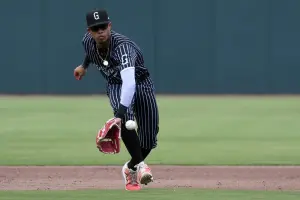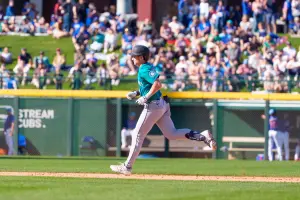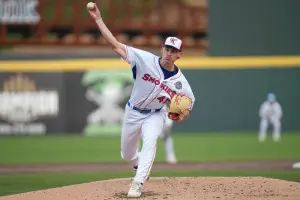
(*) MINORS: The Eyes have it—Michael Chavis & Josh Ockimey
This week we celebrate 20 years at BaseballHQ. In addition to goodies for our subscribers, we've included a free preview of content for non-subscribers. Today, I've been chosen to write our free article, giving non-subscribers a peek at the content the BHQ minors team delivers daily.
We are different from the other guys. As I mentioned in my column last week, many fantasy owners rely on sources for prospect information that are ill-suited for fantasy purposes. While there are lots of quality writers and websites covering prospects, most are not geared towards fantasy owners like BHQ's coverage. Our niche isn't shining a bright spotlight on the next big MLB All-Star; we're more concerned identifying which players will help your fantasy team now and into the future. Sometimes, that future is several years away.
This week, let's look at two Single-A Red Sox corner infielders primed for potential breakouts next season.
Michael Chavis (3B, BOS)
#10 Red Sox prospect (Pre-season)
Dates Seen: 08/30/15, 09/02/15, 07/05/16 & 07/06/16
Most prospects I've covered this season have met or exceeded their expectations in pro ball. Red Sox prospect Michael Chavis is not one of them. Drafted by the Red Sox in the first round of the 2014 draft, Chavis' bat so far as not carried him through the lower minors like many thought it would. He struggled mightily in his first taste of full season ball in 20155. I scouted Chavis at the end of last season with Single-A Greenville. On a team featuring prospects such as Yoán Moncada, Rafael Devers, Andrew Benintendi and Javier Guerra, Chavis was lost in the shuffle. The swing speed and strength of his wrists, hands and forearms did spark my intrigue, but the length of his swing and home run-happy approach was dreadful. Figuring a .223/.277/.405 line would bring a repeat of Single-A, I decided to sit on my report until Greenville passed through Rome this season.
My 2016 look at Chavis was delayed due to an April thumb ligament injury that landed the right-handed hitting third baseman on the DL for six weeks. Prior to the injury, Chavis was off to a torrid start. He has since cooled substantially. In July, Chavis didn't look hindered by the thumb. In fact, he looked completely transformed from the player I saw in 2015. He was attacking the baseball, keeping his hands inside and driving the ball, especially to left and left-center. He was laying off more pitches, and had adjusted his approach. In 2015, he tried to yank every pitch over the fence. In 2016, he looked to make solid contact instead.
The 21-year-old has simplified his swing; a hitch caused reaction issues last year. Instead of making contact out in front of the ball, he allowed pitches into his kitchen, resulting in weak contact or no contact at all. With improved reaction time, Chavis is seeing the ball quicker. He's attacking pitches in the zone and laying off ones falling out of the zone. He still struggles with pitch recognition, which could explain some of his late-season struggles. He also extends early, causing his swing to elongate. Despite the early extension, he possess above-average-to-plus bat speed. In the video package, notice how quickly Chavis gets his bat going. His wrists fire towards the baseball. In my two-game look, he barreled more pitches than any other prospect I scouted this season.
At 5'10'', 190 lbs, Chavis is at physical projection. Despite his short stature, the former first rounder packs a serious punch. Utilizing a sturdy base, strong hands and quick wrists, Chavis' swing generates above-average loft. In batting practice, Chavis didn't struggle pulling pitches out for HRs. In game action, he hammered a double off the LF wall, narrowly missing a HR.
Defensively, Chavis has the arm to play third base but lacks ideal natural reaction skills. A shortstop in high school, he has some range, but that merely offsets his reaction issues. Chavis' hands were softer and he showcased more body control than the last time I scouted him. That said, I like him much better moving to second base than remaining at third. His bat projects better at second too. His below-average foot speed would limit his ability to play the outfield regularly.
Michael Chavis is an imperfect prospect. Will he ever reach the promise of a former first round pick? Probably not. While he has made strides with his hit tool, I still project a .250 hitter, capable of launching 15 to 20 home runs a season.
For fantasy comparison, look no further than Zack Cosart. The Reds shortstop is experiencing a breakout season, slashing .265/.312/.446 with 15 HRs. Cosart's 2016 is the best case scenario for Chavis. Among second baseman, that would leave Chavis as a middle-of-the-pack fantasy option at the position. With development likely placing him in High-A next season, Chavis is likely a buy in the deepest formats only.
There’s more where this came from to help you win your fantasy league this season. Take the title home with a subscription to BaseballHQ.com.
Josh Ockimey (1B, BOS)
Unranked Red Sox prospect (Pre-season)
Dates Seen: 05/29/16, 07/05/16 & 07/06/16
Coming into this season, Josh Ockimey was an afterthought in a loaded Red Sox farm system. A prospect noted for his HR prowess prior to being drafted, the left-handed hitting slugger had combined for only four HRs in 311 short-season at bats. Then, Ockimey emerged. According to Alex Speier of the Boston Globe, Ockimey was fitted for contact lenses. A combination of seeing the ball better and leaning up physically paid dividends during the first half of the season. Entering the South Atlantic League All-Star break, Ockimey was slashing .297/.435/.531 with 10 HRs. Then, he crashed down to earth. In the past two months, he's lost 45 points on his batting average and has seen an uptake in strikeouts. So which player is Josh Ockimey?
In my May look, Ockimey's swing mechanics were solid. His trigger was sound and he drove his hands through the ball. There were inconsistencies incorporating his lower half in his swing. Ockimey didn't always explode his hips on every swing. It is common for hitters on this level to have inconsistencies syncing up their upper and lower halves. It goes with being raw.
By July, lower half inconsistencies were widespread. Relying on his upper half to supply swing speed and power, Ockimey struggled against better velocity. He started sweeping at pitches, extending early. Ockimey was pressing. He was less selective than earlier looks and was not utilizing his strengths, like going the other way. Mostly, Ockimey had fallen into poor habits. Again, it's not an unusual speed bump for raw hitters to experience.
Even as Ockimey has struggled, he's maintained a high OBP. In Single-A, a high OBP isn't necessarily indicate that a prospect has a skill for getting on base. Subpar pitching tends to miss the zone badly against hitters with Ockimey's power and prestige. When scouting a hitter on this level, I watch reactions and how he understands his own hit zone. Ockimey reacts well to pitches, lays off a lot of pitches out of the zone. He mostly has an understanding of what pitches he can drive, too. Although, when he is pressing, he'll let his bat fly on anything in the strike zone.
Since high school, Ockimey has dazzled scouts with his power displays in BP. The raw plus-plus power matches some of the best Single-A prospects I've scouted. In both BP and game action, he flexed tremendous power to all fields. Against Braves prospect Touki Toussaint (Scouting Report), Ockimey drove a pitch off the very top of the 16 foot CF wall in Rome, 402 feet from home plate. Few hitters are capable of driving a ball to that spot in the ballpark. Ockimey power will play plus-plus in the big leagues if his hit tool allows it.
At 6'1, 215 Ibs, Ockimey is a big kid. Entering the season, some scouts thought he was too muscular. Big-bodied, Ockimey leaned up considerably this past off-season.
Ockimey isn't the best athlete. He is a 30 runner (on the 20-80 scale), which will cause issues clogging up base paths. In the field, Ockimey struggles; his footwork needs attention. The left-handed first baseman has solid lateral body control, but struggles reacting to balls in front of him. Ockimey's glove work at the bag is slightly better than previously reported. It's early to worry about Ockimey's defense. I've seen prospects with similar footwork issues in Double-A become everyday MLB first baseman.
Full season ball has taken its toll on Ockimey physically and mentally. It's hard to understand how a 20-year-old professional athlete in peak physical shape can get tired. Coaches have told me only the jump to the big leagues is more difficult than the jump from short season ball to full season ball for young players. A combination of competition ramping up significantly and the grind of a five-month season contribute to player exhaustion. The good prospects learn from it and take measures the next season to prevent exhaustion.
Josh Ockimey is extremely raw. Despite his second half struggles, he is a solid prospect. I don't think it is a matter of if Ockimey figures it out, but when. His feel for hitting is too good to go wasted. Ockimey will need to tighten up his swing mechanics and improve in the field to reach full projection. Full projection is hard to predict. A fantasy projection is even harder to figure out. Given average first base production is often found on waiver wires, wait to snatch up Ockimey for another season.









